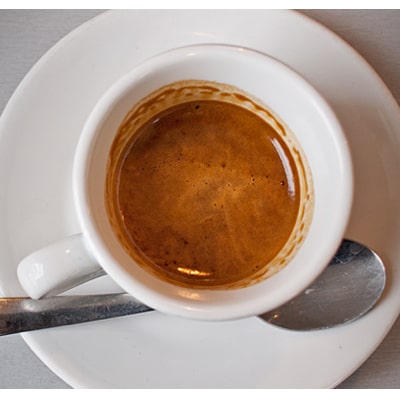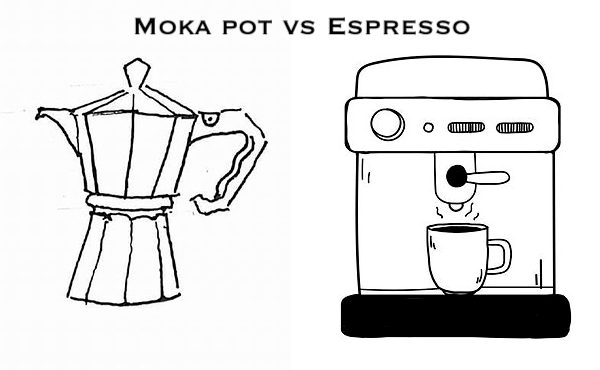Contents
It’s an age-old debate, yet people are still unsure if they can pull out an espresso using a Moka Pot. If you go by the technical definition, the moka coffee is way too different than an Espresso.
Both the Moka Pot & Espresso Machine brew excellent coffee shots – other than this, they have nothing in common. Honestly speaking, I also considered them the same until my recent cafe visit. They are not the same. Period. Moka coffee and espresso follow distinct brewing methods and grind setting. It’s high time you know it. But what are the other factors that make them different? Which one is better suitable for making quality coffee?
Moka Pot vs Espresso Machine
If you ask your grandmom about the moka pot espresso, she’s probably gonna say “yes, Moka Pot makes the best espresso”. Although a professional barista would simply deny it saying that “only the espresso machines brew the proper espresso shot”. Who’s right and wrong here? The barista people of course. When it comes to authentic espresso making, you only got to go with the Espresso Makers.
Apparently, the Moka Pot was advertised as the ‘Stovetop espresso maker’ too. Even the French press is another alternative to espresso brewing. However, all of these don’t brew the true espresso.
To summarize, moka espresso maker don’t give you real espresso.
How to define a Real Espresso Shot?

- the drink made with a pressurized extracting method
- it could be single or a blend of flavors
- uses 7-10 grams of freshly ground beans for a shot of 15-30ml of water
- optimum temperature set for the espresso falls between 195 to 205 F
- the warm water passed through the coffee grounds at a 9 bar pressure
- percolation time won’t be more than 20-30 seconds, excluding the pre-infusion time
- rich, frothy crema on the top
So, that’s how I can define a perfect espresso. Can a moka pot grind the coffee in the same way as an espresso? Which one’s easy to use – moka pot or the espresso? We shall find out soon.
Moka Pot & Espresso Machine – Factor Check
One of the important difference among the two is the pressure factor.
Did you know the coffee prepared in a moka pot makes use of 1-2 bars of pressure?
This value is more than the manual pressure generated by a lever espresso. You can now well imagine the pressure on a typical espresso machine. The standard pressure needed for brewing espresso is found to be 8-10 bars pressure, which is almost 5 times of the moka pressure.
1. Usage
Espresso makers are tough and more complicated than the Moka Pot. This doesn’t mean moka pots are like a breeze, both the methods are equally challenging. You should know what is a moka pot, and an espresso – the functioning to make out the judgment. But comparatively, moka pot gets you going quicker than the espresso machines.
Winner – Moka Pot
2. Time taken for brewing
Moka process can take a total of 10 minutes, starting from the preheating to the final hissing sound which indicates the coffee is ready. Espresso, on the other hand, takes only 10-30 seconds to pull out an espresso shot, but if you consider the heating and prepping time, you will need 5 to 7 minutes. Once you get pro with the espresso machine, it will make up to the fastest brewing time.
Winner – Espresso
3. Who is more versatile?
Both the coffee machines are versatile in their own way. But, the espresso has a more concentrated coffee than moka which makes it a bit more versatile than moka. Also, the flavors are more intact on the espresso, that goes well for further coffee drinks.
Winner – Both, still the espresso percolator makes it better.
4. Capacity
You can prepare 1-12 cups of coffee using the Moka pot, provided the cups are of the size 2 ounces. So, if you want to brew out 12 cups, you will have to use the larger cups. Espresso grind, on the other hand, gives 1-2 espresso shots only but it can prepare you more shots within the same time taken for the Moka pot to finish.
Winner – Moka Pot. Hands down.
5. Flavor
Moka already has the name of stovetop espresso, so the flavor is near to espresso but not exactly the same. Moka has a robust flavor and you could even get the sweet crema. You can get similar results on the brikka stovetop espresso review as well.
On the other hand, espressos are 5 to 8 times concentrated than the drip coffee. It’s bittersweet in taste, and they are more than just strong coffee.
Winner – Espresso (for a true smoky, espresso flavor)
6. Maintenance
For the Moka pot, you need to cool down the machine first. Later, clean out the grounds and send a gush of cool water and rinse the whole system. Coming to the espresso, it’s a bit tricky one. You need to send water shot and a steam shot (for the steam wand, if present) after each espresso brewing. Here, you will also have to clean the portafilter and the filter basket too.
Winner – Moka Pot
7. Cost
You can easily find quality Moka Pots in the range of $30 – $100, however, you can’t apply the same theory as the espresso. This is because low-priced espresso makers don’t last long and may turn out to be inefficient. So, why to go for such a model if it doesn’t do the job well? Therefore, it’s advisable to spend generously on the espresso model.
Winner – Moka Pot (for lower range budgets)
Click here for some of the Best Stovetop Espresso Machines on the market:

Which one should I buy – Moka Pot or the Espresso?
Okay, so let’s get this straight. If you are looking for a real espresso drink (true by all means), then just go with an espresso machine. There’s nothing to think about in this case.
But, it comes with a heavy cost. The high espresso pressure has a price. In that case, you can go with the Moka Pot which is a pretty decent alternative to Espresso drinks. Just make sure you know how does a moka pot work to brew out the coffee from it. You will love using the Moka pot, and the ease of brewing coffee by yourself.
